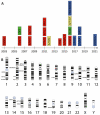Genetic Insights into Primary Restrictive Cardiomyopathy
- PMID: 35456187
- PMCID: PMC9027761
- DOI: 10.3390/jcm11082094
Genetic Insights into Primary Restrictive Cardiomyopathy
Abstract
Restrictive cardiomyopathy is a rare cardiac disease causing severe diastolic dysfunction, ventricular stiffness and dilated atria. In consequence, it induces heart failure often with preserved ejection fraction and is associated with a high mortality. Since it is a poor clinical prognosis, patients with restrictive cardiomyopathy frequently require heart transplantation. Genetic as well as non-genetic factors contribute to restrictive cardiomyopathy and a significant portion of cases are of unknown etiology. However, the genetic forms of restrictive cardiomyopathy and the involved molecular pathomechanisms are only partially understood. In this review, we summarize the current knowledge about primary genetic restrictive cardiomyopathy and describe its genetic landscape, which might be of interest for geneticists as well as for cardiologists.
Keywords: cardiomyopathy; cardiovascular genetics; desmin; filamin-C; restrictive cardiomyopathy; troponin.
Conflict of interest statement
The authors declare no conflict of interest. The funders had no role in the design of the study; in the collection, analyses, or interpretation of data; in the writing of the manuscript, or in the decision to publish the results.
Figures








References
-
- White P., Myers M. The classification of cardiac diagnosis. JAMA. 1921;77:1414–1415.
-
- Gerull B., Klaassen S., Brodehl A. The genetic landscape of cardiomyopathies. In: Erdmann J., Moretti A., editors. Genetic Causes of Cardiac Disease. Springer; Cham, Switzerland: 2019. pp. 45–91.
-
- Elliott P., Andersson B., Arbustini E., Bilinska Z., Cecchi F., Charron P., Dubourg O., Kuhl U., Maisch B., McKenna W.J., et al. Classification of the cardiomyopathies: A position statement from the european society of cardiology working group on myocardial and pericardial diseases. Eur. Heart J. 2008;29:270–276. doi: 10.1093/eurheartj/ehm342. - DOI - PubMed
Publication types
Grants and funding
LinkOut - more resources
Full Text Sources

